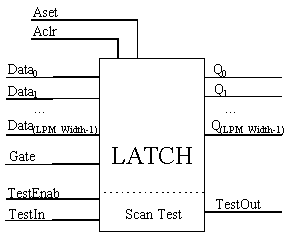![]()
Copyright © 1998 University of Manchester
|
|
|
4.4.1 LPM_LATCH |
|
Copyright © 1998 University of Manchester |
D-Type Latch.

Ports
| Description | Comments | |||
| Data Input to D-Type Latches | Vector, LPM_Width wide
Note 1 | |||
| Latch enable input
High (1) = flow through Low (0) = latch | ||||
| Data output from D-type latches | Vector, LPM_Width wide | |||
| Set latch value to all 1's or to the value of LPM_Avalue, if present. | Note 2, Note 3 | |||
| Clear the latch (set to all 0's) | Note 3 | |||
| Test enable input | ||||
| Serial test data input | ||||
| Serial test data output | TestOut = QLPM_Width-1 |
Note 1: If the Data input is not used, then either Aset or Aclr must be used.
Note 2: Aset will set the count to the value of LPM_Avalue, if that value is present. If no LPM_Avalue is specified, then Aset will set the count to all ones.
Note 3: Aset and Aclr affect the output (Qi ) values before the application of polarity to the ports.
Note 4: Either all of the Test ports must be connected or none
of them.
Properties
| Value | Comments | ||
| LPM Value > 0 | Width of input and output vectors | ||
| LPM Value | Value loaded by Aset | ||
| LPM Value | Value loaded at power-on |
Functions
| Output | ||
| Asynchronous value.
Note 1 | |||
| Latch holds current value (latched) | |||
| Latch is transparent (flow-through) | |||
| Qi is shifted into Qi+1
TestIn is loaded into Q0 |
Note 1: The asynchronous value is determined by which asynchronous port is high: Aclr or Aset. If both asynchronous ports are high, then the output is UNDEFINED. If the LPM_Avalue property is defined, then the Aset port, when active, will set the count to the value of the LPM_Avalue.